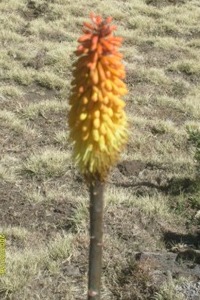|
|
 | |
|
|
|
BALE MOUNTAINS NATIONAL PARK - Highland of Endemism!
|
Bale Mountains National Park was established in 1970 and it is located 6o- 40’N and 39o-40’E at 420 kilometers/ 249 miles southeast of Addis Ababa.
The park is set up in Ethiopia’s second highest massif ranges covering an area of 2,220 square kilometers/ 857 square miles and it is the highest
alpine moorland habitat of Africa which constitutes Mount Tullu Dimtu (4377 meters/14,360 feet), the second highest mountain peak in Ethiopia.
The park is an ideal place for trekkers with extreme highland wilderness and it is one of very well conserved national parks in Ethiopia covering
the vast area of Afro alpine wild flowering vegetation, lakes, dense forest, woodland and moorland with abundant endemic birds and mammals.
Bale National Park offers mountain foot and horse trekking, scenic and game driving with so many opportunities to spot endemic mammals, such as Mountain Nyala,
 Abyssinian Wolf, Menelk’s bushbuck, Giant mole rat, Bohor Reedbuck and birds, such as, Blue-winged Goose, Wattled crane, Rouget's Rail, and many more.
• AVERAGE ALTITUDE: 2500 meters / 8,202 feet.
• MAJOR PHYSICAL FEATURES: The escarpment which extends from east to west and the high and vast volcanic plateau rising more than 4000 meters /13,123
feet moorland dotted with black water alpine lakes, creeks and waterfalls. Tullu Dimtu is the highest peak and the second highest mountain in Ethiopia at
4,377 meters/ 14,361 feet.
• CLIMATE: The mountainous region of Bale experiences rainfall during the long wet season (July through October) and short wet (March and mid-June)
with an average temperature 10oC/50 oF. Beautiful blue skies can be seen during the days of the dry season which stars in November through February with
average day time temperature of 20oC/68 oF and the nights are cooler.
• FLORA: The great altitudinal variation together with the amount of rainfall influences the vegetation in Bale. The plains within an altitude
of 2500 meter / 8,202 feet are covered with Juniper procera and Hygeia abyssinica trees. At 3,500-3,700 meters/11,482-12,139 feet the sparsely
grown trees are dominated by giant heather; and the Afro alpine vast moorland by Everlasting (helichrysum) and Giant Lobelia (Lobelia rynchopetalum).
Along the escarpment Red hot poker (Kniphofia spp) are found while the area above 3,700 meters/ feet are covered by grasses.
• FAUNA: Bale Mountain National Park is gifted with widely varied endemism of mammals from rodents such as Giant Mole Rat to big antelope such as
Mountain Nyala, Menelik Bushbuck and Ethiopian wolf.
The park has registered 170 highland bird species of which sixteen are exclusive. The Harenna Forest is Ethiopia’s unexplored dense forest nested by numerous forest birds. The alpine lakes at the top of Senetti plateau are rich in endemic birdlife of Ethiopia: Blue winged goose, wattled Ibis, thick billed Raven, white collared pigeon, black winged Love bird, Rouget’s Rail and Abyssinian Long claw.
Hiking and trekking in the park guarantees the abundance of fauna even in short period of time.
Abyssinian Wolf, Menelk’s bushbuck, Giant mole rat, Bohor Reedbuck and birds, such as, Blue-winged Goose, Wattled crane, Rouget's Rail, and many more.
• AVERAGE ALTITUDE: 2500 meters / 8,202 feet.
• MAJOR PHYSICAL FEATURES: The escarpment which extends from east to west and the high and vast volcanic plateau rising more than 4000 meters /13,123
feet moorland dotted with black water alpine lakes, creeks and waterfalls. Tullu Dimtu is the highest peak and the second highest mountain in Ethiopia at
4,377 meters/ 14,361 feet.
• CLIMATE: The mountainous region of Bale experiences rainfall during the long wet season (July through October) and short wet (March and mid-June)
with an average temperature 10oC/50 oF. Beautiful blue skies can be seen during the days of the dry season which stars in November through February with
average day time temperature of 20oC/68 oF and the nights are cooler.
• FLORA: The great altitudinal variation together with the amount of rainfall influences the vegetation in Bale. The plains within an altitude
of 2500 meter / 8,202 feet are covered with Juniper procera and Hygeia abyssinica trees. At 3,500-3,700 meters/11,482-12,139 feet the sparsely
grown trees are dominated by giant heather; and the Afro alpine vast moorland by Everlasting (helichrysum) and Giant Lobelia (Lobelia rynchopetalum).
Along the escarpment Red hot poker (Kniphofia spp) are found while the area above 3,700 meters/ feet are covered by grasses.
• FAUNA: Bale Mountain National Park is gifted with widely varied endemism of mammals from rodents such as Giant Mole Rat to big antelope such as
Mountain Nyala, Menelik Bushbuck and Ethiopian wolf.
The park has registered 170 highland bird species of which sixteen are exclusive. The Harenna Forest is Ethiopia’s unexplored dense forest nested by numerous forest birds. The alpine lakes at the top of Senetti plateau are rich in endemic birdlife of Ethiopia: Blue winged goose, wattled Ibis, thick billed Raven, white collared pigeon, black winged Love bird, Rouget’s Rail and Abyssinian Long claw.
Hiking and trekking in the park guarantees the abundance of fauna even in short period of time.
|
| WHEN TO VISIT BALE MOUNTAINS
|
|
|
| Best season to explore the park starts in October through March. Blue sky with colorful wild flowers bloom at the beginning of the dry season.
We organize hiking & trekking tours to the Bale Mountains escorted by trekking guides.And We guarantee you to see many endemic plants,
animals, and birds in the wilderness.
|
|
|
| |